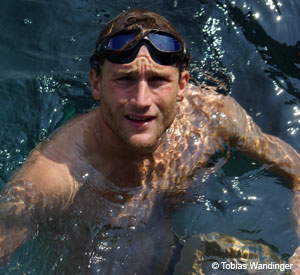Cannondale’s Slice for 2008
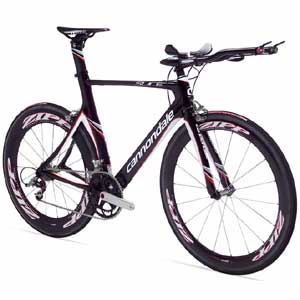
Cannondale, the company, is a recovering alumaholic. Formerly addicted to metal — fat and round — this brand segued its timed race bikes to skinny flat carbon tubes with welded aluminum lugs. As of last year Cannondale weaned itself off metal entirely (in time trial), and its recent triathlon iteration is an all-carbon monocoque that diverges from its pedigree, but does not dishonor it.
The model just prior to this was the Ironman Six 13 Slice Si and that was way too many words. If you need that many words in your bike’s name you’re compensating for something your bike lacks.
This latest bike is simply called the Slice, and that right there is a big improvement.
The Ironman name is golden for some companies, but it didn’t bump Cannondale’s sales. As of this moment Cannondale is not saying that it’s no longer the Ironman licensee, but I think the writing is on the wall, because the writing is certainly not on the bike. Better to just build a good bike, I think, in place of relying on the opportunities the Ironman license affords you. This is what Cannondale seems to have decided, based on its current body language.
Not that triathletes were necessarily the prime movers in this new bike’s development. Cannondale’s most important promotional property is the Liquigas cycling team, and that squad needed a first class time trial bike. Maybe that’s what got the lead of of C’dale’s pants and put ants in there instead. Whether or not this team provided the primary motivation for this bike’s development, the primary market for it is triathlon. Triathletes will buy it if it is built correctly.
So, did Cannondale build it correctly? It depends on what it is you value. We’ll cover the frame and its features; the geometry; and the value of the Slice models vis-à-vis price. First, the frame.
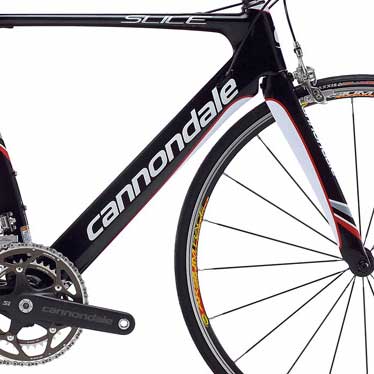
And by frame I refer to its features, aerodynamics, cosmetics — everything except its geometry.
Prior to, oh, the turn of the century, it was hard to tell whether aero bikes were truly aero. Shaped tubes were as likely to slow a bike down as to speed it up. We know more today about what makes a bike fast than ever before. We can tell by looking at a frame whether it’s likely to be fast.
The Slice does three important things well. Its down tube is skinny (30mm or narrower in its minor diameter), while maintaining a nice aspect ratio. The seat tube provides a shape behind which the rear wheel can hide from the wind. And the seat tube and mast appears to be in shapes that allow for at least reasonably good airflow. Then there is that all-important fourth element: the fork. I don’t know whether this is a World Class wind beater, but the rest of the bike seems a varsity effort, so it’s a fair wager to suspect that the fork executes as well.
Now, about that geometry. Cannondale has artfully built two bikes in one. Remember that this bike is primarily for the Liquigas Team’s time trials. If you assume that the UCI’s regulations are to be followed to the letter, and not softened by the granting of morphological exceptions, C’dale needed to make a bike that would work well at 75 or so degrees of seat angle. This the Slice does.
So how can it also work well at 78 or 79 degrees of seat angle, which is where its best pro male triathlete (Faris Al Sultan) rides, as do many or most of the Slice’s prospective customers? There are two answers to this. First, the bike has a two-position seat post, so you can physically get yourself to 80 degrees if you want.
Second, there’s the way Cannondale gets the bike to ride nicely when ridden steep. It accomplishes this by slowing the steering way down. While most tri bikes exhibit a “trail” of about 58mm or 59mm, this 72-degree head angle bike features a fork with 45mm of offset, which grants the rider a slower-responding 62mm of trail. The bike wants to go in a straight line. When you’re in the aero position, it’s a dream to ride.
The critically thinking reader might bring up a couple of arguments to counter this. This greater amount of trail, for example, does not have any affect on weight displacement. If you ride it steep you’re going to have to shorten the cockpit so as you move your saddle forward. In order to lengthen that cockpit back out to match your fit coordinates, you’ll have to place a longer stem on the bike. This means you’ll have a lot of your weight on the front wheel. This is not ideal for descents.
Of course, you could opt for a bigger size (this frame is built in 5 sizes). But the head tube lengths increase correspondingly. That’s fine if you’re tall of leg and short of torso, otherwise, you might find the head tubes a challenge. I’m 6’2”, and if I ride this bike steep, the 58cm Slice has the right head tube length for me (145mm), but is too short in the top tube. The 60cm size has the right top tube (57.5cm, which will be artificially shortened as I ride the bike steeper than its actual seat angle), but the bike’s 170mm head tube is a challenge (not a deal breaker, but a challenge).
There is one other issue to note. Because of its geometry, if you ride the size you’d expect to ride (instead of sizing up and accepting an over-tall head tube), you’ll have a long steering lever with this bike because of the longer than typical stem. This is most keenly felt when out of the aero position, with the hands contacting the pursuits. This long lever, along with the slowed-down steering geometry, makes this bike, quite frankly, a dog when you’re out of the saddle.
This may not matter to the riders who aren’t doing a lot of high speed descending down switchback-laden mountains, nor to those who spend much time out of the saddle. In this case, the new Slice may well be for you. If you keep yourself to the aero position, and you’re not facing steep, technical descents, it’s hard to imagine a nicer-riding bike.
What about value? Cannondale has gone the route of others (most notably Scott) and abandoned the lower price points in favor of producing a single, upper-end, frame and offering it with a variety of groupkits. The Slice frame is packaged for a complete bike sale costing $3500 up to $10,000, depending on how you want it. Interestingly, the most expensive variation is not the one where you get the built-in SRM. The power-equipped option will cost you $8500.
About that $3500 option: this slots you into a spot in between Cervelo’s P2C and its P3C, a little more dear than Trek’s entry level Equinox TTX, and right around the price point of Felt’s B2. Tactically, Cannondale is well positioned with this bike.
This least expensive version of the Slice is the Slice 5, and it’s 105-equipped. Changes from OE spec are required. The aerobar — Profile Design’s Airwing and T2 aerobars with alloy extensions are fine… if you upgrade the extensions to Cobras. If the head tube of your Slice is too tall, these’ll have to be yanked off in favor of Profile Design’s new lower-profile clamps on its Carbon Stryke, or else it’s the Sonic Stryke, or aerobars from another bar maker entirely.
The wheels and tires are a little too OE for a frame this nice, you’ll want to invest in a second set of wheels for training. If you live among hills (even the rolling hills you tend to find all over California’s coastal areas) you’ll probably want to consider switching the 130mm bolt pattern cranks out for some compacts.
Or you could just go with the Slice 3, featuring the next groupkit up, and you get a bit of Ultegra, plus the Cobra extensions, and Mavic Aksium wheels. The bike is $500 more dollars than the Slice 5, and comes pretty race ready at that price. This model is the pick of the litter.
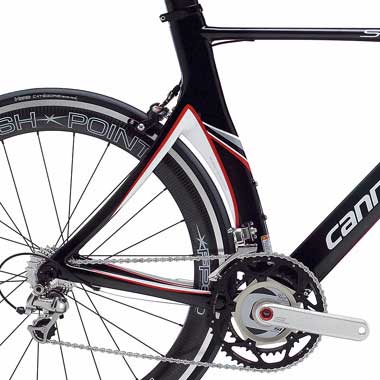
The Slice 1 is a big next step up and at $6000 probably an unnecessary one. Will somebody please explain to me why all these companies insist on putting race wheels OE on their upper end models? QR, Felt, Scott, everybody seems to be doing this. Look, when I buy a jockstrap, I just want a jockstrap. I don’t want a package deal, where I get socks with it. I’ll buy the socks separate. I don’t need your help in determining what socks are the most appropriate cosmetic and technical match for my jockstrap. Got that? Is it Crystal yet, or do I need to squirt it with Windex and make it more so?
While it might seem spendy, $8500 for the Slice SRM is not a bad option. You’ve got the same bike as the Slice 1 above, but with SRMs in place of the Cannondale house-brand carbon crank. If you’re going to train and race with power, the SRM is typically considered the acme, and I think that’s a pretty good price for the unit.
But… nobody is going to ride a frame this nice, with Dura Ace parts (and, for a nice touch, SRAM’s very nice aero brake levers), with an SRM crank, and Zipp Flashpoints! You’re going to ride it with Zipp’s 808s!
So, if I see you riding a Slice 1 with Flashpoints, I’m going to walk over and key your bike’s paint job. Tell your retailer to take those wheels off and sell them aftermarket to a guy who wants race wheels for his Felt S32, and have them replaced with a decent set of training wheels. Try to get it, spec’d out this way, for $7500 (all they can do is say no).
Selah.
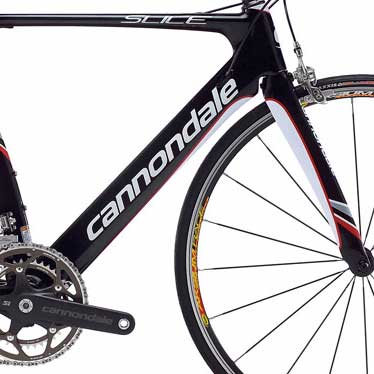
In closing, I really like the Cannondale Slice for our triathlon community. Just riding along on flattish terrain, I don’t remember when I’ve been on a bike that rides this nice. It might be the best 75- and 76-degree bike on the market today.
Let’s say you’re riding this semi-shallow config, yet you want a bike that allows you the ability to creep forward, should that be your eventual destiny. This may be your bike.
The Slice is also a value: a first class frame for good complete bike money.
Just know that no bike is everything to everybody, and this one, if ridden steep, is going to be tall (if you choose it a size up to get the extra cockpit); or it’s going to be front-end weighted (if you choose the “right on paper” size). It’s no big problem to ride it a bit front-end weighted, if you’re not doing a lot of technical descents.
If you’re a steep-angled rider and technical descents are on the menu for you, then you’ll have to decide whether the Slice is your best option. If you want it nonetheless, then you’ll want your Slice in the next size up, along with a probable change of stem and aerobars to something very flat and low profile.


